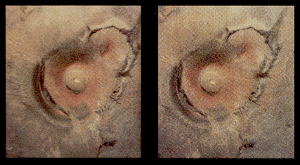

James Turrell, a leading exponent of the light-and-space school of California artists, has exhibited a series of three-dimensional photographs at Karl Bornstein Gallery which document the evolution of his Roden Crater project. Since the sixties, Turrell has explored the nature of our perception of space, and his use of stereophotography is a logical extension of these esthetic concerns.
Depth perception is the result of binary visual input. Binocular stereopsis (literally "solid seeing") is a phenomenon by which two discrete views are fused in the brain into a single cyclopean image with a volumetric character. This obvious but startling fact is rarely exploited in the fine arts. Three-dimensional imaging constitutes not just a documentary visual mimesis, but a shift of consciousness by which we become aware of our own perceptual mechanics.
The exhibit of work by Turrell, titled "Aerial Stereos", consisted of large (48" x 48") double-image photographs of the crater, taken from an airplane at altitudes between 7,400 and 11,400 feet. The two stereophotographs, mounted side-by-side on the walls, were viewed through a device known as a Wheatstone reflecting stereoscope (invented by Charles Wheatstone in 1838) modified to accommodate the large format. When seen through the viewer, the two images are separated for each eye, but they are fused by the brain into a single, three-dimensional image.
Turrell, who is a pilot and aviation buff, took these photographs with an old army aerial camera loaded with large-format (10" x 10") color film. In these aerial photographs, the distance between the two exposures was roughly two hundred feet, and this interocular distance produced a hyper-stereo effect, exaggerating the three-dimensional sense of depth in the image. One view of the crater shot from 11,400 feet created a curious perceptual effect of miniaturization.
A single large anaglyphic photograph (48" x 60") depicting a detail of the crater was included in the exhibit. To produce an anaglyph, two separate black and white photographs are encoded in red and blue and then composited; the resulting image is viewed through red and blue glasses and yields a monochromatic, three-dimensional image. While wearing glasses, one could walk about the anaglyphic photograph and view planar shifts interactively, whereas the side-by-side stereos could only be viewed through the Wheatstone device that was fixed to the floor of the gallery. On the gallery's south wall was a large pastel drawing of the crater, sectioned off into a grid.
Through this exhibit, Turrell hoped to develop greater public recognition of his work with the crater and enlist further support for this massive project, which he expected would require at least six years and more than three million dollars for its completion. The Roden Crater itself is a five-hundred thousand-year-old extinct volcano which Turrell is altering to create an environmental artwork that will capture celestial light energies and permit observations of atmospheric conditions. Located near Flagstaff, Arizona, the crater rises six hundred feet above the Painted Desert and is set in a lava field that contains almost three hundred craters. When completed, the piece will include a series of seven major chambers that will engage events in the skies. Additionally, there will be a one-thousand-foot-long tunnel shaped to accommodate a perceptual phenomenon known as "celestial vaulting," in which the sky appears to be a huge, domed ceiling.
With this innovative art exhibit, Turrell made a purely documentary use of stereo photography to record some of the spatial dynamics of the Roden Crater. The exhibit, however, could be appreciated for its inherent virtues even without its relationship to Turrell's project. "Aerial Stereos" was an interesting exploration of the problematic nature of cyclopean perception.
first published in February 26, 1985 issue of Artweek
